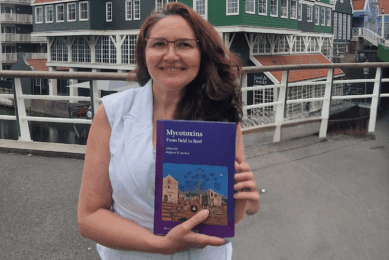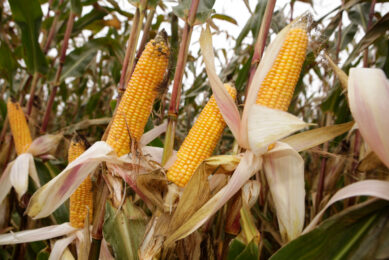Dr Lina Castano-Duque: “Predictive tools are needed to prevent mycotoxin outbreaks”

‘Predictive models to manage mycotoxin outbreaks in the USA’ is the title of USDA researcher Dr Castano-Duque’s presentation at the 14th edition of the World Mycotoxin Forum. In this interview she talks about her presentation, what the mycotoxin situation currently is in the US and what she sees as challenges in the world of mycotoxins.
Mycotoxin outbreaks are an issue worldwide. Could you explain more about the current situation in the US?
Indeed! In the United States, mycotoxin contamination of corn occurs sporadically, especially during warm, dry years. We follow the guidelines from the US Food and Drug Administration, for food the aflatoxin level limits are 20 ppb and for fumonisin 5 ppm. These limits are a bit more stringent for milk (0.5 ppb of aflatoxin) and popcorn (3 ppm of fumonisin). Absence of predictive models for mycotoxin outbreaks in corn grown in the USA prompted us to work on this area, similar to what’s being done in Europe.
The major threats that lead to more mycotoxin outbreaks are climate change due to global warming, and timely implementation of region-specific pest management strategies to control mycotoxin contamination. Simulation models predict that aflatoxin and fumonisin problems will increase and geospatially migrate to northern latitudes at an alarming rate due to global warming and associated factors.
Currently there are no risk management smart technologies available for the US farmers and stakeholders for mycotoxin risk management and prevention of outbreaks. In the southern states of the USA, where the climate tends to have warm spring and hot summer with possible drought conditions, the biocontrol approaches using non-toxigenic strains of Aspergillus flavus is routinely implemented to prevent aflatoxin outbreaks.
What were your reasons for carrying out the study on ‘Predictive models to manage mycotoxin outbreaks in the US’ and were there any unexpected results?
As I mentioned before, currently in the USA there is no smart technological solution available to predict the outbreak of mycotoxin. Our current research efforts are focused on predicting mycotoxin contamination event in US-grown corn. Several years ago, the National Corn Growers Association voiced the need to USDA leaders for smart technologies that can help stakeholders prevent mycotoxin outbreaks in the USA. This need was the basis for the USDA-ARS to initiate research on developing US-focused models to understand how the biotic and abiotic parameters such as weather, satellite-acquired data on vegetation indices, soil properties, land usage and other factors correlate with mycotoxin outbreaks. In due course, we were able to collaborate with international and domestic partnerships. We worked closely with the scientists in the Netherlands, university partners in the USA and several scientists associated with state departments of agriculture in the corn-growing states. Our initial modelling efforts for the state of Illinois demonstrated some of the results made sense; some novel and some unexpected results about the variables linked to mycotoxin outbreaks at a historical geospatial level. We demonstrated a high rate of prediction (94%) in Illinois-grown corn in our first study. We successfully implemented this model for Iowa-grown corn as well. We hope to train this model to other corn-growing states, one at a time, in collaboration with State agri-department officials and university partners. We have also embarked on understanding how the variable parameters used in the model are biologically relevant to the outbreaks. Use of additional parameters to fine tune our modelling effort is ongoing, and it is essential to develop a reliable model. We are thankful to have the collaboration from several domestic and international scientists. Finally, to be able to predict dangerous mycotoxin outbreaks in a timely and specific geospatial manner will assist us to manage and mitigate that risk in an efficient manner.
You touched on the subject of climate change being a challenge in the industry, what else do you consider to be a challenge?
Yes, climate change is a big driving force to worry about mycotoxin contamination of food and fed products around the world. In addition to that, one of the biggest challenges that we are facing is the implementation and the application of those smart technologies for risk assessment. It is currently not available in the US market.
Do you think collaborating with others from the industry would help overcome this challenge?
Yes, collaboration between the USA, the USDA as well as other agencies, private academic is the way to go. Currently, we are collaborating at a national and international level. At an international level we are collaborating with the Wageningen Institute in the Netherlands. Here in the US, we are collaborating with several USDA scientists and academics in the fields of hydrology and in the fields of soil sciences plant pathology. Beyond the collaboration with scientists is the channel of communication that needs to be opened with scientists, farmers and the stakeholders. The development of these smart technologies needs to be created with the cooperation of the stakeholders. We need to know what their needs are and not only to develop, but to continue developing the tools, the models to ensure we have up-to-date data that we can use to fine tune the models with what is happening every single year. That’s key to be able to grow the research programme to continue growing the smart technologies.
Dr Lina Castano-Duque gave her presentation in the ‘Data-driven mycotoxin management’ session during the World Mycotoxin Forum.
Join 13,000+ subscribers
Subscribe to our newsletter to stay updated about all the need-to-know content in the dairy sector, two times a week.






